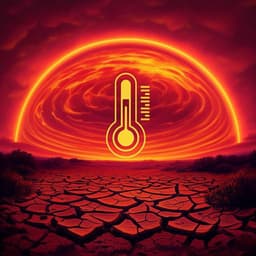
Earth Sciences
Projected increase in summer heat-dome-like stationary waves over Northwestern North America
Z. Chen, J. Lu, et al.
This groundbreaking research conducted by Ziming Chen, Jian Lu, Chuan-Chieh Chang, Sandro W. Lubis, and L. Ruby Leung uncovers a startling 95% increase in summer stationary wave amplitude projected for Northwestern North America, primarily due to tropical Pacific heating changes. The findings suggest that heatwave risks in the region may escalate significantly by the end of the century.
~3 min • Beginner • English
Introduction
Stationary waves are large-scale atmospheric circulation anomalies on monthly or longer time scales and play a central role in shaping regional climate and extreme weather. The unprecedented summer 2021 heatwave in Northwestern North America was associated with a strong anticyclonic (heat-dome-like) upper-tropospheric circulation, contributing to major societal and ecological impacts. Prior work has focused more on winter stationary waves, which generally show equivalent-barotropic responses and eastward phase shifts with increasing CO2, and mid–high-latitude weakening under high-emission scenarios. In contrast, summer stationary waves have received less attention. In the tropics, future summer stationary waves are projected to weaken due to increased oceanic moisture and moist static energy (MSE) from SST warming, which reduces land–sea MSE contrast and weakens overturning circulations; land warming can partly offset this by enhancing MSE maxima and convection over land. Responses differ in midlatitudes near 45°N: over Northwestern North America, the likelihood of heat-dome-like anticyclonic circulation is projected to increase under high emissions, and soil moisture–atmosphere nonlinearities can further amplify heat extremes. Despite these insights, the projected changes in summer stationary waves over Northwestern North America and their drivers remain unclear. This study targets those changes and the dominant mechanisms. Using CMIP6 models and a stationary wave model with Rossby wave diagnostics, we identify diabatic heating increases over the tropical Pacific and a northward-expanding waveguide as key drivers of enhanced anticyclonic circulation, implying elevated future heatwave risk in the region.
Literature Review
Previous studies have established key aspects of stationary waves and their climate-change responses. Winter stationary waves in the Northern Hemisphere tend to weaken (≈15–30%) and shift eastward with rising CO2, often exhibiting equivalent-barotropic structures. In summer, tropical stationary waves weaken due to increased oceanic moisture/MSE under SST warming, which reduces land–sea MSE contrast and weakens tropical overturning circulations; reductions in the tropical Pacific zonal SST gradient further weaken subtropical stationary waves. Conversely, land surface warming enhances MSE maxima and convection over land, partially compensating the weakening by modulating land–sea contrasts. Heat extremes such as the 1988 U.S. drought, 2003 European heatwave, and the 2021 Pacific Northwest heatwave have been linked to anomalous stationary waves and heat-dome-like anticyclonic circulations; soil moisture–atmosphere feedbacks can explain a substantial fraction of temperature anomalies (e.g., ~40% in 2021). Prior single-model projections suggested only a weak increase in heat-dome-like circulation probability over Northwestern North America. Uncertainties in tropical air–sea coupling patterns (e.g., El Niño-like warming), ITCZ shifts, and the interplay of transient eddies, stationary waves, and diabatic heating contribute to projection spread.
Methodology
- Datasets: ERA5 reanalysis (0.25°×0.25°, 137 levels) for 1950–present; monthly output from 26 CMIP6 models and daily output from 18 CMIP6 models for historical (1995–2014) and future SSP2-4.5 and SSP5-8.5 projections. All data regridded to 2.5°×2.5° (first-order conservative) and bilinear for circulation patterns. First available realization per model used.
- Index definition: An eddy meridional wind dipole index (V200) defined as the difference in 200 hPa eddy meridional wind between western (43°N–58°N, 120°W–140°W) and eastern (43°N–58°N, 90°W–110°W) flanks of the anticyclonic circulation.
- Detection and trends: Trends in the dipole index evaluated in ERA5 (1979–2018) and CMIP6 historical (1979–2014) using Mann–Kendall test. Future changes assessed for 2080–2099 versus 1995–2014 under SSP5-8.5 and SSP2-4.5.
- Stationary wave model (SWM): A time-dependent baroclinic model (R30 horizontal truncation; 24 sigma levels) solving 3D nonlinear primitive equations for deviations about prescribed basic states (winds, temperature, surface pressure). Forcings: 3D diabatic heating (DH), transient vorticity (TFv) and transient divergence (TFd) fluxes, and orography. Damping: Newtonian cooling, Rayleigh friction, biharmonic diffusion.
- Forcing construction: 3D basic states from CMIP6 MMM for 1995–2014 and 2080–2099. DH diagnosed as thermodynamic residual using analyzed vertical velocity from 14 CMIP6 models; TFv and TFd computed from 3D daily winds. MMM formed on pressure levels then interpolated to sigma levels.
- SWM experiments: CTRL (historical forcings) and PROJ (projected forcings) runs, each integrated 100 days; quasi-steady averages from days 30–100. Sensitivity runs fixing one forcing (DH, TFv, or TFd) at historical values while others are projected to isolate contributions; nonlinearity defined as PROJ minus sum of single-forcing responses. Model noise defined as twice the standard deviation over days 30–100.
- Regional DH experiments: SWM responses driven by DH changes confined to broad regions (tropics 20°S–20°N; northern subtropics 20°N–40°N; mid–high latitudes 40°S–70°N) and finer subregions (tropical Pacific, North Atlantic, North America, North Pacific, East Asian monsoon, tropical Indian Ocean).
- Diagnostics: Eddy meridional wind (V) and eddy streamfunction (ϕ′) at 200 and 850 hPa; pattern correlation coefficient (PCC) and RMSE between SWM and CMIP6 MMM responses. Regression of detrended summer daily Tmax onto detrended standardized dipole index (ERA5 and CMIP6). Rossby waveguide via stationary zonal wavenumber Ks on Mercator projection; Rossby wave source S = −∇·(vχ ξ) and its decomposition into divergent flow and absolute vorticity contributions; horizontal wave activity flux (Plumb) at 200 hPa; ray tracing (beta-plane, stationary ω=0, initial zonal wavenumber 4) to track propagation from a tropical NE Pacific source region for 10 days.
- Model agreement: Stippling/white dots where ≥70% of models agree in sign; significance via Student’s t-test for regressions.
Key Findings
- Robust strengthening of anticyclonic stationary wave over Northwestern North America in boreal summer: dipole index increases by 95% (±1σ across models: −36% to 226%) for 2080–2099 vs. 1995–2014 under SSP5-8.5.
- Historical increase already detectable: ERA5 trend significant (p<0.02); CMIP6 historical trend significant (p<0.001) for 1979–2014.
- Circulation pattern: Positive (negative) V200 eddy anomalies over northwestern (midwestern) North America with >70% model sign agreement; corresponding positive eddy streamfunction anomaly over Northwestern North America at 200 hPa and supportive lower-tropospheric structure.
- Tmax linkage: Strong positive association between dipole index and summer daily Tmax over Northwestern North America in ERA5 (robust regression) and in future projections; intermodel correlation r=0.77 (p<0.001) between changes in dipole index and regional Tmax.
- Mechanism dominance: SWM sensitivity shows diabatic heating (DH) changes dominate the projected V200 and ϕ′200 responses (PCC with PROJ: 0.98 and 0.99, respectively). Vorticity forcing partly offsets DH; similar cancellation at 850 hPa.
- Source region of forcing: Tropical Pacific DH is the predominant driver of the upper-tropospheric stationary wave response over Northwestern North America (SWM PCC=0.87). North Atlantic (PCC=0.53) and North America (PCC=0.33) DH contribute secondarily; other regions have weak or negligible contributions.
- Teleconnection pathway: CMIP6 projections show (i) expansion of the Rossby waveguide over North America (linked to poleward shift of the westerly jet), favoring more northward propagation of waves, and (ii) enhanced Rossby wave source over the tropical NE Pacific due to tropical Pacific DH changes and associated divergent flow anomalies. Resultant wave activity flux increases into the Pacific coast and Northwestern North America, reinforcing the anticyclonic anomaly.
- Model–SWM consistency: SWM reproduces key features of CMIP6 MMM responses (ϕ′ PCCs: 0.84 at 200 hPa, 0.95 at 850 hPa; V PCCs ~0.59–0.60), though with some positional biases aloft.
- Frequency change: Daily CMIP6 outputs indicate a significant increase in the frequency of positive dipole index days in boreal summer for 2080–2099 (SSP5-8.5), not evident in other seasons—implying more frequent heat-dome-like patterns.
- Projection uncertainty: Differences across models in tropical Pacific DH changes (e.g., strength of El Niño-like warming and ITCZ response) align with spread in the dipole index response; models with stronger tropical Pacific DH increases show greater stationary wave strengthening.
Discussion
The study directly addresses how and why summer stationary waves over Northwestern North America will change with warming. The projected doubling (~95%) of the anticyclonic stationary wave amplitude links dynamically to enhanced heatwave risk via subsidence, cloud reduction, and increased shortwave radiation, consistent with observed and modeled Tmax regressions against the dipole index. Mechanistically, tropical Pacific diabatic heating changes are the primary driver, establishing a teleconnection: a dipole in tropical eastern Pacific heating enhances divergent flow and the Rossby wave source in the tropical NE Pacific. Concurrently, a poleward expansion of the upper-level waveguide over North America promotes northward propagation of Rossby wave activity into the region. These processes collectively amplify the heat-dome-like circulation. The findings integrate CMIP6 diagnostics with an idealized stationary wave model and wave propagation theory, increasing confidence in the attribution of projected circulation changes and their heatwave implications. Remaining spread is linked to uncertainties in tropical air–sea coupling patterns and local land–atmosphere feedbacks, which can modulate the amplitude of the anticyclonic response.
Conclusion
The anticyclonic, heat-dome-like stationary wave circulation over Northwestern North America is projected to nearly double in summer by late century under high emissions, with similar strengthening under intermediate emissions. Stationary wave model experiments and CMIP6 diagnostics jointly identify increased tropical Pacific diabatic heating and a northward-expanding waveguide as the principal dynamical drivers. These circulation changes strongly elevate the likelihood and severity of summer heatwaves in the region by favoring subsidence and warming. Future research should quantify the relative roles of tropical ocean–atmosphere coupling (e.g., El Niño-like warming and ITCZ shifts) versus local land–atmosphere interactions (e.g., soil moisture feedbacks) in setting the magnitude of the response, assess seasonal and regional dependencies, and further refine idealized models to capture transient eddy–stationary wave–heating interactions.
Limitations
- Stationary wave model biases: southeastward shift/exaggeration of upper-level anticyclonic anomalies relative to CMIP6 MMM; southward/southeastward biases in westerly jet and V200 in CTRL; simplified dynamics cannot fully represent transient eddy–stationary wave–diabatic heating interactions.
- Projection uncertainty: Strong dependence on tropical Pacific diabatic heating changes and associated air–sea coupling patterns (e.g., El Niño-like warming, ITCZ shifts) that remain uncertain across models.
- Seasonal specificity: Robust increases in positive dipole index frequency are confined to boreal summer; limited evidence for other seasons.
- Model and data choices: Use of single realization per CMIP6 model and regridding may influence MMM characteristics; DH diagnosed as a residual can carry uncertainties from circulation and temperature analyses.
- Regional forcing decomposition: Contributions from non-Pacific regions are assessed but carry uncertainties due to model simplifications and potential nonlinear interactions.
Related Publications
Explore these studies to deepen your understanding of the subject.







